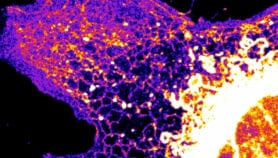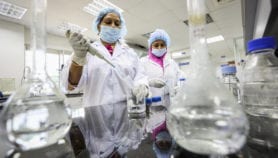By: David Dickson
Send to a friend
The details you provide on this page will not be used to send unsolicited email, and will not be sold to a 3rd party. See privacy policy.
Misguided attempts, led by the United States and the Vatican, to seek a global ban on all forms of human cloning threaten to undermine efforts to introduce more reasonable regulation.
Sometime next month — if press reports are to be believed — an Italian researcher expects to be able to announce to the world a major 'first' for modern science: the successful birth of the first cloned human being. But there is unlikely to be much rejoicing in the scientific community. Most scientists believe such a step to be highly premature, both morally and scientifically.
The scientific qualms are based on growing evidence that the cloning 'successes' announced in recent years — starting with the birth of Dolly, the first cloned sheep, in 1997 — have a larger down-side than initially appeared. In particular, animals reproduced in this way may suffer forms of genetic damage that have yet to be fully understood. Dolly herself, for example, suffers from arthritis that could have a genetic basis; similarly a study published in September by researchers from the Whitehead Institute for Biomedical Research in Boston found that one in 25 genes taken from the placenta of cloned mice was abnormal, with other genetic problems in the animals' livers.
The moral problems with reproductive cloning remain equally challenging. There could be certain circumstances — for example, couples faced with infertility — in which the positive aspects of reproductive cloning might outweigh any negative implications. But there are many other circumstances (such as the replacement of a dead child with a genetically identical copy) in which the motivations are likely to be much more ambiguous, if not overtly unethical.
The case for a global ban
In such circumstances, efforts to achieve a global ban on the cloning of grown humans — at least until the scientific and moral problems involved have reached a much higher resolution than they do today — makes much sense. Without a global consensus on this issue (and, even more importantly, a willingness on the part of individual nations to incorporate this consensus into national legislation) there will always be mavericks prepared to do what they feel they can get away with.
There is therefore good reason to support the efforts currently being made within the United Nations to secure such a ban, known under its full title as "an international convention against the reproductive cloning of human beings". And there is equally good reason to deplore a current campaign being led by the United States and the Vatican which, ironically, is significantly reducing the chances that such a ban is ever likely to be agreed on, let alone put into effect.
The irony comes from the fact that what the United States and the Vatican — backed not only by some Catholic countries but also by various Arab and Muslim states — are seeking is a much stronger treaty that would include a ban not only on the cloning of grown human beings, but also on human embryos.
Their position reflects the strongly-held views of the anti-abortion movement, backed by the Catholic Church, that a fertilised embryo represents a "potential human being", and should therefore be treated in the same way as fully grown humans. But this is strongly opposed by others who argue that there is a significant difference between a fertilised embryo and a human foetus. This group includes many scientists who claim that work on fertilised embryos — and in particular, on ways to grow the stem cells obtained from such embryos into human tissue that can be used to replace damaged organs — holds out immense potential value for medical therapies.
A crucial distinction
Advocates of such research insist, with justification, on the need to maintain a sharp distinction between the cloning of embryos to obtain material that can be used in such research — known as therapeutic cloning — and the technique of reproductive cloning, aimed at reproducing full human beings. The first, they argue, should be allowed under carefully regulated circumstances; the second, they claim, should be banned, at least until more is known about the risks involved.
The draft of the international convention that had been put to a committee of the United Nations earlier this month — and some had hoped would then be passed to the United Nations itself early next year — would have done precisely that. Reflecting the reality that consensus on the second of these is likely to be much easier to achieve than on the first, the draft would have outlawed reproductive cloning, but remained silent on the more controversial topic of therapeutic cloning (somewhat comparable to international efforts to ban the use of nuclear weapons, but tolerate the use of nuclear power stations in carefully controlled conditions).
But the United States will have none of this. Apparently reflecting the dominance of conservative anti-abortionists within supporters of the current Republican administration, it has adopted an "all or nothing approach that would embrace a ban on both reproductive and therapeutic cloning". Such a move would effectively outlaw any scientist wishing to carry out research on embryonic stem cells.
Few dispute the crude logic of the US position — namely that studying tissue taken from a "potential human being" that has been sacrificed in the interests of medical research can, from one point of view, be seen as unethical — even if they may profoundly disagree with it. Different cultures, and more particularly different religions, have different attitudes to the question of when human life can be taken to begin. This diversity needs to be respected. It is clear that the 'scientific' answer — that 'life' begins about 14 days after conception, when the appearance of the so-called 'primitive streak' provides the first indication of the embryo as an identifiable human being — is not automatically accepted by all (even though there is a strong case that it should be).
Dangers of a legislative vacuum
The main problem with the US/Vatican position is a more pragmatic difficulty, namely that by raising the stakes in the negotiations, it also raises the chances that no agreement will be reached at all. In such circumstances, the field would remain open for the mavericks to continue their experiments unimpeded by international laws.
It is another irony of the current situation that the United States itself is already facing such a situation. Congressional control over the federal budget, backed by conservative interpretations of current legislation, have created a situation in which it is illegal for public funds to be used for research using human embryos. At the same time, however, a failure to reach consensus on the issue itself has created a legal vacuum within which such research can carry on unimpeded — provided it takes place within the private sector.
The danger now is that, as a result of the US action, this scenario will be reproduced at the international level. It is difficult to believe that this situation will please anyone (apart from those able to exploit it for their own purposes). Those seeking a much-needed international treaty that bans reproductive cloning will have been thwarted. Those genuinely seeking tougher measures will remain frustrated. The only victors will be those keen to make a public display of their ideological purity on this issue. And no-one — apart from their political supporters — is likely to benefit from that.
© SciDev.Net 2002













